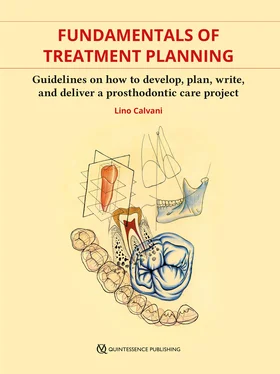1 ...7 8 9 11 12 13 ...25 However, no matter what past experience or personal problems patients may have that could result in a negative attitude on their part, we need to know, understand, and remember to behave professionally at all times in order to inspire trust in our patients and communicate effectively with them.
3. Patient management
This is one of the most important skills we need to develop for success in the clinic. Patient management depends mainly on us, and according to psychology is based on two personal qualities of the clinician that should be carefully nurtured and developed: the ability to take responsibility and our freedom of choice (free will).
Some patients have demanding personalities or suffer from complex psychologic problems. These factors could affect our ability to manage their cases. 4For this reason, when we are dealing with difficult patients, we need to pay even more careful attention to our interpersonal management skills because problems with these challenging patients may arise at any time.
Psychologic studies suggest that we should be professionally confident and capable and should take responsibility for everything we say and do. The more we transfer positive feelings to our patients, the more they will trust us and the easier it will be for them to accept the treatment we offer them. A number of psychologists have studied patient–clinician behavior and the kind of relations that should be established from the first visit. It has been noted that if we succeed in our intentions, our self-esteem increases, which in turn increases the positive attitude of our patients and the mutual ability to communicate and collaborate. 4
Psychologic studies also highlight the importance of knowing how to evaluate patient feedback when we start to create a bond with our patients. 4According to the Oxford English Dictionary definition, feedback is “the information about the result of a process or action that can be used to modify or control a process or system.” It is therefore important to learn how to listen to our patients so that we are better able to help them. That is patient management in a nutshell.
4. Positive professional characteristics
Patient management is not an easy task to perform. To achieve success, we should always behave in an impeccable and appropriate professional manner – from the moment we first meet our patients, through the first dataset acquisition and case assessment, the explanation of the diagnosis and prognosis, the delivery and discussion of the proposed treatment plan, and finally throughout the entire clinical treatment and follow-up process. Professionalism in our appearance, our manner of speaking and listening, our body language (non-verbal communication), and our general attitude and demeanor is essential to the professional and respectful relationship we build with our patients. Every action has a reaction or consequence. Actions we take as professional caregivers are directly related to how our patients perceive us from the beginning and will have an impact on how much respect and trust they have in us – and ultimately in the success of the treatment. We need to listen carefully, be flexible in our approach, be adaptable to our patients’ needs, and respond with respect and empathy to their questions, requests, and concerns.
Priorities
Simply put, when patients seek our help, they do so according to their own personal priorities. These priorities will differ for each patient. For some, the priority will be pain relief, which can be seen as an emergency. For others, it may be relief from discomfort, or perhaps unhappiness with the appearance of their smile or teeth. Our role is to assess these priorities and solve the case in such a way that the patient’s priorities are respected.
The ideal treatment plan
Is there an ideal treatment for all patients? First and foremost, the Latin phrase ‘primum non nocere’ (above all, do no harm) – included in the Hippocratic Oath – should be the medical principle that guides our minds and hands. In this respect, the ideal treatment plan is one that achieves the best possible long-term prognosis with the minimum of necessary intervention, and which addresses all the patient’s concerns and problems. 5- 7
Can this ideal treatment plan be achieved with every patient? There are many answers to this question, and this book explores them in some detail. A guiding principle could be the KISS rule. KISS is an acronym for ‘keep it simple, stupid’ or ‘keep it simple stupid,’ which was a design principle of the US Navy in 1960. The KISS principle states that most systems work best if they are kept simple rather than made complicated; therefore, simplicity should be a key goal in design, and unnecessary complexity should be avoided. Basing a treatment plan on this principle means that we seek out a simplified course of action and solution to avoid the complications that may arise when things become more complex, both during the treatment and in the long term. However, it is not as simple as this. Due to today’s digital technological environment and more sophisticated prosthetic rehabilitation options, simple may not always be the best option. Perhaps KISS should therefore be amended to ‘keep it simple, sometimes.’ Therefore, while the rule of simplicity when conceiving a treatment plan is a sound notion, it is not always entirely possible, nor is it always necessarily the best option. Again, flexibility is required in our thinking. We also need to bear in mind that with increasing complexity comes increasing compromise. 8- 19
Compromise
Perfection should be the ultimate goal in treatment planning, although it is seldom possible to achieve. Despite our best intentions, we are usually forced to compromise. Experience tells us that even when the outcome is clear from the start, we need to propose more than one possible solution.
Furthermore, we should remember that there is no ideal treatment plan that fits all cases. Each patient is unique. We therefore need to be open-minded and knowledgeable enough to treat our patients using a range of possible treatments and prosthetic tools. Moreover, there is not one treatment plan for each patient, but possibly many. This depends on variables such as evidence, clinical factors, prosthetic limitations, and patient preference. It also depends on what is objectively possible and what we can imagine and plan within the context of the specific case.
Also, despite the number of treatment options that we devise and customize for each patient, there is usually one treatment plan that we particularly prefer for that patient. And then it sometimes happens that for a number of reasons the patient prefers a treatment other than the one we prefer.
Indeed, to restore and rehabilitate a patient’s mouth we usually have to agree to one or more compromises that we hopefully have foreseen. We then need to inform our patients of the final treatment plan in such a way that they properly understand it, agree to it as the best treatment for them, and willingly approve it. 18- 30
Therefore, we need to search for the best compromise that will achieve the ideal outcome for that particular patient, always taking into account the following four patient realities:
1. Chief complaint.
2. Health status.
3. Motivation/will.
4. Financial situation.
Prosthodontic treatments are never easy and are usually time consuming, both clinically and technically. Therefore, considering the high expectations of most patients, we would do well to heed Bolender’s advice: “Communication to avoid frustration!” 31, 32The right compromise can be reached only if both parties, the clinician and the patient, clearly communicate and agree. That is why it is so important for us to carefully pay attention and listen closely to our patients. It is also crucial to clearly and carefully explain to our patients what we can do for them (possibly in front of witnesses in cases where it is considered necessary) so that they clearly understand the limitations in terms of the clinical and technical realities. In this way, their expectations will not exceed what is feasible and possible in the circumstances and in terms of our professional capabilities. 13, 16, 20- 25, 29, 33, 34- 36
Читать дальше












